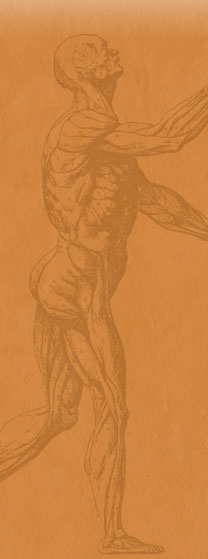9. Traditionally, motion testing has focused on the feeling of tissue restriction at the end-range of the motion being palpated. Functional methods focus upon the tissue response at the beginning of movement. How do you explain this difference? This is a bit technical to explain in an interview format. In the Functional Methods courses that I teach we show a nice cartoon that demonstrates the loss of easy neutral around a dysfunctional motion axis. In these situations, movement in either direction away from the disturbed midline is met with immediate resistence or ease, both palpated responses in the tissues surrounding the dysfunctional segment. In other words the resting tone of the tissue is increased, with associated loss of easy neutral mechanics. When palpated, these tissues increase or decrease their tone at the initiation of motions introduced in any direction (opposite responses are palpated when motion is tested in the opposite direction). This is not to say that palpatory responses occurring at the end range of motion don’t exist or aren’t useful. In functional methods we just focus on the initial responses because, for 7 axis of motion, it is much easier to assess and manage in a time efficient manner.
10. Fred Mitchell Jr. and Bill Johnston independently examined the same patients and compared their findings in an experiment they performed. Mitchell wrote that they disagreed on the direction of motion restriction in 2/3 of the cases. Are structural and functional approaches inconsistent then? This is a very interesting finding from this experiment and I believe it has to do with the difference in approach towards diagnosis that we see this discrepancy. In Functional Methods we use the palpatory responses to motion testing described previously to map out a 3-segment complex of dysfunction where the segments above and below the central segment behave in opposite manners. This verifies the exact location of the segment that is primary. Frequently, with positional diagnosis, the central (primary) segment is not identified but rather the segment with the most rotation or restriction is assumed to be the primary one. In many cases, there is another dysfunction 2 segments away that is also disturbed, which may make the segment between them the primary one. This can be verified by testing motion responses at all 3-segments to confirm which is the central segment. I’m sure that Drs. Johnston and Mitchell did not always agree on the exact location of the dysfunction and therefore directions of restriction might be opposite…
11/12/13. Charles Bowles was considered one of the originators of Functional Technique, how did he and Johnston cooperate and what did he mean by the concept of “the mobile unit within a mobile system”? What was Harold Hoover’s role in the development of Functional Technique? Yes it is generally true that Hoover and Bowles were the ones originally making functional ideas known and then Dr. Johnston took their ideas and developed them further. The idea of a mobile unit within a mobile system came from Bowles interpretation of systems theory (cybernetics) applied to the biological understanding of living systems, specifically the musculoskeletal system. His concept regarded the motor system as a dynamic co-operative functional mechanism with local musculoskeletal disturbances being interconnected and reflecting imbalances in the system as a whole. His approach regarded the musculoskeletal system as a problem-solving machine with specific responses to passive motion testing providing the information to understand functional relationships between different body regions and functional strategies for restoring normal motion. Bowles formulated these ideas, which became the basis of Functional Methods. Hoover’s work describing indirect techniques greatly influenced Bowles and Johnston but he never collaborated with them specifically on applying systems theory to Osteopathy.
The observation and description of a 3-segment motion response complex and the linkage of findings in viscero-somatic disturbances were the work of Bill Johnston. Also, he developed the approaches to working with the sacropelvis and costal cage as multiple mobile columns (3 columns in the costal cage and 2 in the pelvis).
The Johnston family has uncovered an interesting collection of correspondence between Johnston, Bowles and Korr that occurred over many years. These three were intrigued by the implications of this emerging field of cybernetics, the study of biological control systems, and its impact on the application and understanding of Osteopathic principles in research and practice. Their correspondence contains many interesting discussions that reflect the depth of each one’s thinking and understanding on this subject and will probably be published in the coming years.
14/18. Functional methods work in diagnosis and therapy with feed-back loops, can you explain this? Feedback loops are a part of our neurophysiology, they are mechanisms which underlie the way we function. As such, feedback loops are an active part of every approach to assessment and treatment. They help us to better understand why what we do works. In Functional Methods we apply this understanding in a very simplified form, with the focus on palpatory responses, not visual or conceptual relations. This keeps us focused on the unique musculoskeletal aspects of each individual in terms of motor system control and its associated function. We can choose to look at what’s going on in a dysfunctional neuromusculoskeletal system in many different ways, some complex others simple. The difference with this approach is that we describe findings using the same language inherent in the body’s functional design output (mobile responses) and we incorporate multiple regional inputs in total body positioning for resolution of dysfunctions that exhibit a total body pattern of disturbed (motor) function. It is better to say that Functional Methods work with the motor control system, of which feedback loops are certainly a part.
15. Are there Somatic Dysfunctions that cannot be diagnosed via the system of Functional methods? In the most general sense, no, I mean if we use the classic definition of somatic dysfunction, because all tissues demonstrate responses to motion, therefore it works for every situation where motion testing is applied.. All tissues in the body reflect tension and respond to postural or other physiologic demands with some type of motion response, even fluids. The palpatory skill of the practitioner is the only limitation in terms of which tissues can, or can’t, be palpated. The only exception to this might be biodynamic diagnosis, which often involves no motion testing at all (so no response of ease or bind) but rather an assessment of the inherent vitality or potency within the tissues themselves. Even with the small amount of motion testing sometimes used in cranial diagnosis, there is no motion response of absolute ease or bind in this system because the axis of motions are not fixed but shifting (between phases of flexion and extension, for example), so tension within the system is also shifting, defying the classic 2 dimensional ease vs bind paradigm…. For treatment, positioning is often used to balance tension around the fulcrum (the point or axis around which the tension is organized) similar to functional positioning, however the result is not an immediate resolution of tension but rather a stimulation of the midline fluid matrix that then slowly corrects the disturbance. Often in biodynamic treatment the response that is palpated is a shift in the fluid potency that comes from just observation and not from any kind of motion testing.
16. How did Dr. Johnston come to the integration of visceral information? Throughout his early career, Dr. Johnston observed unique relationships between different body regions while applying functional motion testing in his patients. These became the foundation for many of his subsequent investigations for further study. One such study began at the Chicago College of Osteopathic Medicine looking at patients with hypertension over a 10-year period in the late 70’s. In this study which was published in multiple articles in the JAOA , he identified the linkage pattern for hypertension in hundreds of patients that were followed over a 10 year period. The discovery of this linkage phenomenon is certainly a landmark for the Osteopathic profession and a highlight of Dr. Johnston’s legacy. Its treatment often results in profound body-wide changes that have significant impact on the clinical course of musculoskeletal and visceral aspects of a patient’s health.
17. What does tapping mean?“Tapping” means to hit something lightly in a repeated manner. This procedure is often used to perform a quick scan of tissues to assess their relative health. If tissues are hypertonic or congested they respond to tapping with less rebound and more resistence. It is a skill we teach in Functional Methods courses which gives similar information as a deep tissue shear test, telling the examiner where the general areas of dysfunction are located. This is always followed by a segmental evaluation to characterize its exact location (central segment) and motion parameters.



